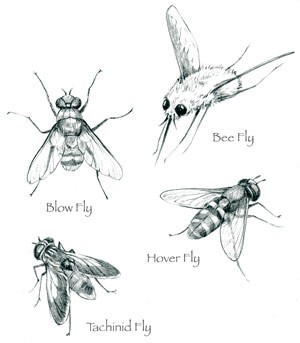
The poet Ogden Nash put it succinctly: “God in His wisdom / Made the fly /
And then forgot / To tell us why.”
True, it’s blackfly season, which is perhaps not the best time of year to convince you that some flies are our friends. But not all flies deserve the disgust we heap on the tribe, for there are species that control pests, pollinate flowers, and some that are even beautiful in their way. There is more to flies than the malaria-carrying mosquitoes and the tsetse of crossword puzzle fame.
The true flies make up a diverse group of insects called the Diptera, so named because they have only two (di-) wings (-ptera). That’s a key trait for the fly-watcher, for many beneficial flies mimic the behaviors of bees and wasps, which have four wings.
The most endearing of the beneficial flies, the syrphid or “hover” flies, are among these bee/wasp look-alikes. They are very common, but because they typically wear black-and-yellow bee suits and act so much like bees, they are usually mistaken for them. Watch for syrphid flies near flowers, where they may hover motionless for long periods of time. The adults are nectar- and pollen-feeders, and after bees, they are the most important insect pollinators.
Syrphid fly virtues are not limited to the adults, though. The larvae of some species are predators that specialize on aphids. If you are unlucky enough to have a hearty population of aphids on your home fruit trees, take a close look. You may see a small creature that looks sort of, but not quite, like a headless caterpillar, swinging the narrow front end of its body from side to side in search of an aphid. Once contact is made, the larva hooks onto the aphid and sucks it dry. By the time it is mature, the larva is eating 60 aphids a day.
The “bee flies” are another family of flower-pollinating flies whose members often look like bees – but bees with long, stiletto-like proboscises. They are hairy beasts, sometimes striped, sometimes with patterned wings. One common and widespread species, the greater bee fly (Bombylius major), holds its two, dark-bordered wings out at an angle while at rest, giving the fly the look of a miniature stealth fighter on Rogaine. Bee flies, like syrphid flies, let their larvae do the dirty work: in this case, parasitizing cutworms, beetle grubs, bee and wasp larvae, and grasshopper eggs.
With the tachinid (tak’ i nid) flies, we leave behind the bee mimics. Many tachinids look more or less like the basic house fly, although there is some variety in color, size, and shape. What they lack in visual appeal, however, the tachinids make up for in their importance as the natural enemies of plant pests. The larvae of the entire family of over 1,300 species are parasitic on insects. Their victims are mostly caterpillars and adult and larval beetles, though some tachinid flies kill sawfly larvae, true bugs, grasshoppers, and other insects. Several species of tachinid flies have been imported as control agents for pests, with varied success.
The smoke-colored wings and orange abdomen of one of the native tachinids, Trichopoda pennipes, may catch your eye as it hovers over squash plants in the garden. It lays its eggs on those pesky squash bugs and other true bugs. When the eggs hatch, the larva burrows into its host and consumes it from the inside out.
Another family of fly-like flies, the blow flies, contributes to pest control as well. One striking example is that of Sarcophaga aldrichi, a parasite of the forest tent caterpillar. The forest tent caterpillar undergoes regular population explosions during which it strips its hardwood habitat bare of leaves. Enter our hero(ine). With so many hosts available, the fly population builds and builds. Finally, parasitism becomes so heavy that caterpillar numbers crash. During peak periods, the flies are so abundant that they become a real nuisance. Its numbers, active flight, fondness for sugar, and habit of landing on people have earned Sarcophaga aldrichi the name, “the friendly fly.”
There has been much research about how to attract and keep beneficial flies in the garden. The obvious key is to provide what they need: safe places to hide and rest, an environment free of insecticides, and, for bee flies and syrphid flies, nectar and pollen. The flies, who are not as smart, strong, or long-tongued as bees, favor plants with numerous small flowers that have easily available nectar and pollen. For this reason, some of the best plants for attracting beneficial flies are sweet alyssum, buckwheat, and members of the carrot family, such as dill, Queen Anne’s lace, parsley, caraway, and fennel.
Making homes for these flies, then, is a winning proposition: more flowers, more flies. So hold off on the Flit.

